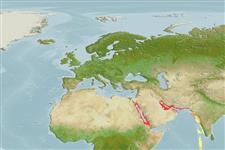Teleostei (teleosts) >
Gobiiformes (Gobies) >
Gobiidae (Gobies) > Gobiinae
Etymology: Callogobius: Greek, kalos, kallos = beautiful + Latin, gobius = gudgeon (Ref. 45335).
Eponymy: Dr Menachem Dor (1901–1998) was a zoologist and Hebrew scholar. [...] (Ref. 128868), visit book page.
Environment: milieu / climate zone / depth range / distribution range
Ecology
Marine; demersal; depth range 5 - 27 m (Ref. 116311). Tropical
Western Indian Ocean: Red Sea.
Size / Weight / Age
Maturity: Lm ? range ? - ? cm
Max length : 2.4 cm SL male/unsexed; (Ref. 116311)
Short description
Identification keys | Morphology | Morphometrics
Dorsal spines (total): 7; Dorsal soft rays (total): 9; Anal spines: 1; Anal soft rays: 7. This species is distinguished from its congeners by the following set of characters: presence of interorbital pores B’, D, E, F, G and H’; no preopercular canal and temporal canal; D VI + I,9; A I,7; scales in lateral series 24-26; colour of body tan to dark brown with narrow, dark longitudinal stripes; a large diffuse black spot dorsally in caudal fin (Ref. 116311).
Specimens collected from the base of coral patches on silty sand of a closed lagoon at depths of 5-7 m, with one collection reaching 21-27 m (Ref. 116311).
Life cycle and mating behavior
Maturity | Reproduction | Spawning | Eggs | Fecundity | Larvae
McAllister, D.E., 1990. A working list of fishes of the world. Copies available from D.E. McAllister, Canadian Museum of Nature, P.O. Box 3443, Ottawa, Ontario K1P 6P4, Canada. 2661 p. plus 1270 p. Index. (Ref. 27116)
IUCN Red List Status (Ref. 130435: Version 2024-1)
Threat to humans
Harmless
Human uses
Fisheries: of no interest
Tools
Special reports
Download XML
Internet sources
Estimates based on models
Preferred temperature (Ref.
123201): 26.3 - 29.4, mean 29 °C (based on 72 cells).
Phylogenetic diversity index (Ref.
82804): PD
50 = 0.5000 [Uniqueness, from 0.5 = low to 2.0 = high].
Bayesian length-weight: a=0.00724 (0.00339 - 0.01546), b=3.10 (2.92 - 3.28), in cm total length, based on LWR estimates for this (Sub)family-body shape (Ref.
93245).
Trophic level (Ref.
69278): 3.1 ±0.3 se; based on size and trophs of closest relatives
Resilience (Ref.
120179): High, minimum population doubling time less than 15 months (Preliminary K or Fecundity.).
Fishing Vulnerability (Ref.
59153): Low vulnerability (10 of 100).
